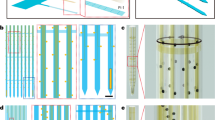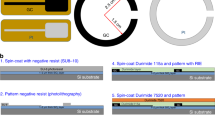Abstract
Direct electrical recording and stimulation of neural activity using micro-fabricated silicon and metal micro-wire probes have contributed extensively to basic neuroscience and therapeutic applications; however, the dimensional and mechanical mismatch of these probes with the brain tissue limits their stability in chronic implants and decreases the neuron–device contact. Here, we demonstrate the realization of a three-dimensional macroporous nanoelectronic brain probe that combines ultra-flexibility and subcellular feature sizes to overcome these limitations. Built-in strains controlling the local geometry of the macroporous devices are designed to optimize the neuron/probe interface and to promote integration with the brain tissue while introducing minimal mechanical perturbation. The ultra-flexible probes were implanted frozen into rodent brains and used to record multiplexed local field potentials and single-unit action potentials from the somatosensory cortex. Significantly, histology analysis revealed filling-in of neural tissue through the macroporous network and attractive neuron–probe interactions, consistent with long-term biocompatibility of the device.
This is a preview of subscription content, access via your institution
Access options
Subscribe to this journal
Receive 12 print issues and online access
$259.00 per year
only $21.58 per issue
Buy this article
- Purchase on Springer Link
- Instant access to full article PDF
Prices may be subject to local taxes which are calculated during checkout




Similar content being viewed by others
References
Alivisatos, A. P. et al. Neuroscience. The brain activity map. Science 339, 1284–1285 (2013).
Birmingham, K. et al. Bioelectronic medicines: A research roadmap. Nature Rev. Drug Discov. 13, 399–400 (2014).
Shen, H. Neurotechnology: BRAIN storm. Nature 503, 26–28 (2013).
Polikov, V. S., Tresco, P. A. & Reichert, W. M. Response of brain tissue to chronically implanted neural electrodes. J. Neurosci. Methods 148, 1–18 (2005).
Olsen, S. R., Bortone, D. S., Adesnik, H. & Scanziani, M. Gain control by layer six in cortical circuits of vision. Nature 483, 47–52 (2012).
Mizuseki, K., Diba, K., Pastalkova, E. & Buzsaki, G. Hippocampal CA1 pyramidal cells form functionally distinct sublayers. Nature Neurosci. 14, 1174–1181 (2011).
Hochberg, L. R. et al. Reach and grasp by people with tetraplegia using a neurally controlled robotic arm. Nature 485, 372–375 (2012).
Nicolelis, M. A. Actions from thoughts. Nature 409, 403–407 (2001).
Taylor, D. M., Tillery, S. I. & Schwartz, A. B. Direct cortical control of 3D neuroprosthetic devices. Science 296, 1829–1832 (2002).
Perlmutter, J. S. & Mink, J. W. Deep brain stimulation. Annu. Rev. Neurosci. 29, 229–257 (2006).
Seymour, J. P. & Kipke, D. R. Neural probe design for reduced tissue encapsulation in CNS. Biomaterials 28, 3594–3607 (2007).
Kozai, T. D. & Kipke, D. R. Insertion shuttle with carboxyl terminated self-assembled monolayer coatings for implanting flexible polymer neural probes in the brain. J. Neurosci. Methods 184, 199–205 (2009).
HajjHassan, M., Chodavarapu, V. & Musallam, S. NeuroMEMS: Neural Probe Microtechnologies. Sensors 8, 6704–6726 (2008).
Kozai, T. D. et al. Ultrasmall implantable composite microelectrodes with bioactive surfaces for chronic neural interfaces. Nature Mater. 11, 1065–1073 (2012).
Seymour, J. P. & Kipke, D. R. Fabrication of polymer neural probes with sub-cellular features for reduced tissue encapsulation. Conf. Proc. IEEE Eng. Med. Biol. Soc. 1, 4606–4609 (2006).
Kim, T. I. et al. Injectable, cellular-scale optoelectronics with applications for wireless optogenetics. Science 340, 211–216 (2013).
Sohal, H. S. et al. The sinusoidal probe: A new approach to improve electrode longevity. Front. Neuroeng. 7, 10 (2014).
Nicolelis, M. A. et al. Chronic, multisite, multielectrode recordings in macaque monkeys. Proc. Natl Acad. Sci. USA 100, 11041–11046 (2003).
Rousche, P. J. & Normann, R. A. Chronic recording capability of the Utah Intracortical Electrode Array in cat sensory cortex. J. Neurosci. Methods 82, 1–15 (1998).
Kipke, D. R., Vetter, R. J., Williams, J. C. & Hetke, J. F. Silicon-substrate intracortical microelectrode arrays for long-term recording of neuronal spike activity in cerebral cortex. IEEE Trans. Neural Syst. Rehabil. Eng. 11, 151–155 (2003).
Miller, K., Chinzei, K., Orssengo, G. & Bednarz, P. Mechanical properties of brain tissue in-vivo: Experiment and computer simulation. J. Biomech. 33, 1369–1376 (2000).
Perge, J. A. et al. Intra-day signal instabilities affect decoding performance in an intracortical neural interface system. J. Neural Eng. 10, 036004 (2013).
Biran, R., Martin, D. C. & Tresco, P. A. The brain tissue response to implanted silicon microelectrode arrays is increased when the device is tethered to the skull. J. Biomed. Mater. Res. A 82, 169–178 (2007).
Dickey, A. S., Suminski, A., Amit, Y. & Hatsopoulos, N. G. Single-unit stability using chronically implanted multielectrode arrays. J. Neurophysiol. 102, 1331–1339 (2009).
Jackson, A. & Fetz, E. E. Compact movable microwire array for long-term chronic unit recording in cerebral cortex of primates. J. Neurophysiol. 98, 3109–3118 (2007).
Tee, B. C., Wang, C., Allen, R. & Bao, Z. An electrically and mechanically self-healing composite with pressure- and flexion-sensitive properties for electronic skin applications. Nature Nanotech. 7, 825–832 (2012).
Mannoor, M. S. et al. 3D printed bionic ears. Nano Lett. 13, 2634–2639 (2013).
Jeong, J. W. et al. Soft materials in neuroengineering for hard problems in neuroscience. Neuron 86, 175–186 (2015).
Spira, M. E. & Hai, A. Multi-electrode array technologies for neuroscience and cardiology. Nature Nanotech. 8, 83–94 (2013).
Kruskal, P. B., Jiang, Z., Gao, T. & Lieber, C. M. Beyond the patch clamp: Nanotechnologies for intracellular recording. Neuron 86, 21–24 (2015).
Tian, B. et al. Macroporous nanowire nanoelectronic scaffolds for synthetic tissues. Nature Mater. 11, 986–994 (2012).
Liu, J. et al. Syringe-injectable electronics. Nature Nanotech. 10, 629–636 (2015).
Liu, J. et al. Multifunctional three-dimensional macroporous nanoelectronic networks for smart materials. Proc. Natl Acad. Sci. USA 110, 6694–6699 (2013).
Lee, H., Bellamkonda, R. V., Sun, W. & Levenston, M. E. Biomechanical analysis of silicon microelectrode-induced strain in the brain. J. Neural Eng. 2, 81–89 (2005).
Rousche, P. J. et al. Flexible polyimide-based intracortical electrode arrays with bioactive capability. IEEE Trans. Biomed. Eng. 48, 361–371 (2001).
du Roure, O. et al. Force mapping in epithelial cell migration. Proc. Natl Acad. Sci. USA 102, 2390–2395 (2005).
Sharp, A. A., Ortega, A. M., Restrepo, D., Curran-Everett, D. & Gall, K. In vivo penetration mechanics and mechanical properties of mouse brain tissue at micrometer scales. IEEE Trans. Biomed. Eng. 56, 45–53 (2009).
Petersen, C. C. The functional organization of the barrel cortex. Neuron 56, 339–355 (2007).
Boulton, A. A., Baker, G. B. & Vanderwolf, C. H. Neurophysiological Techniques (Humana Press, 1990).
Sheeba, J. H., Stefanovska, A. & McClintock, P. V. Neuronal synchrony during anesthesia: A thalamocortical model. Biophys. J. 95, 2722–2727 (2008).
Kajikawa, Y. & Schroeder, C. E. How local is the local field potential? Neuron 72, 847–858 (2011).
Stratton, P. et al. Action potential waveform variability limits multi-unit separation in freely behaving rats. PLoS ONE 7, e38482 (2012).
Biran, R., Martin, D. C. & Tresco, P. A. Neuronal cell loss accompanies the brain tissue response to chronically implanted silicon microelectrode arrays. Exp. Neurol. 195, 115–126 (2005).
Acknowledgements
We thank J. Tian for help and discussions on animal surgeries. This study was supported by Air Force Office of Scientific Research and NSSEFF awards (C.M.L.).
Author information
Authors and Affiliations
Contributions
C.X., J.L. and C.M.L. conceived the idea and designed the experiments. C.X., J.L., T.-M.F., X.D. and W.Z. performed the experiments and analyses. C.X. and C.M.L. wrote the manuscript. All authors discussed the results, interpreted the findings and reviewed the manuscript.
Corresponding authors
Ethics declarations
Competing interests
The authors declare no competing financial interests.
Supplementary information
Supplementary Information
Supplementary Information (PDF 1953 kb)
Supplementary Information
Supplementary Movie 1 (MOV 3977 kb)
Supplementary Information
Supplementary Movie 2 (MOV 5204 kb)
Rights and permissions
About this article
Cite this article
Xie, C., Liu, J., Fu, TM. et al. Three-dimensional macroporous nanoelectronic networks as minimally invasive brain probes. Nature Mater 14, 1286–1292 (2015). https://doi.org/10.1038/nmat4427
Received:
Accepted:
Published:
Issue Date:
DOI: https://doi.org/10.1038/nmat4427
This article is cited by
-
3D spatiotemporally scalable in vivo neural probes based on fluorinated elastomers
Nature Nanotechnology (2024)
-
Implantable intracortical microelectrodes: reviewing the present with a focus on the future
Microsystems & Nanoengineering (2023)
-
Translational opportunities and challenges of invasive electrodes for neural interfaces
Nature Biomedical Engineering (2023)
-
Flexible brain–computer interfaces
Nature Electronics (2023)
-
Scalable batch fabrication of ultrathin flexible neural probes using a bioresorbable silk layer
Microsystems & Nanoengineering (2022)



